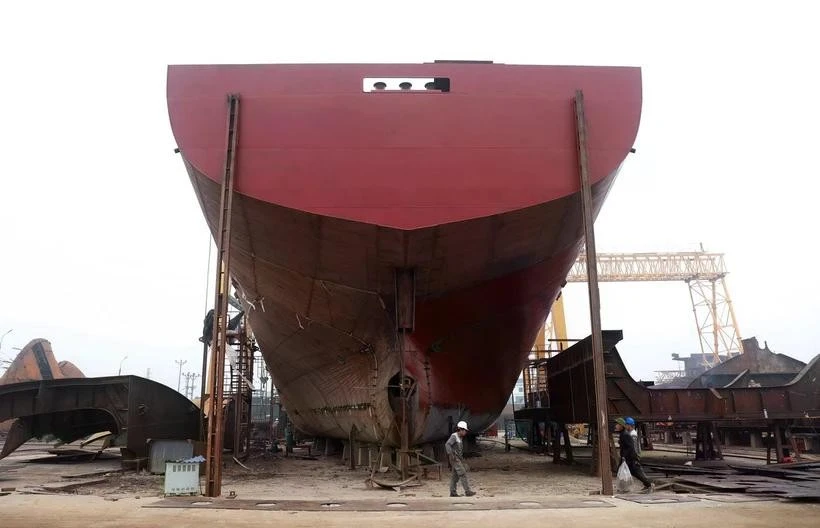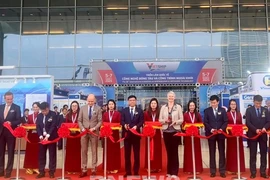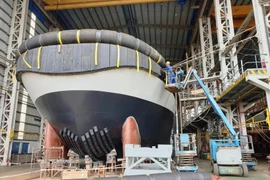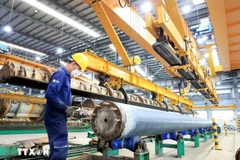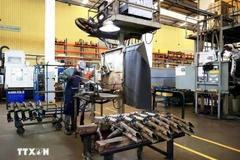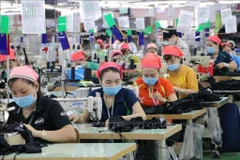Hanoi (VNA) – As domestic and global demand for new ships continues to rise, Vietnam's shipbuilding industry has significant potential for growth.
Currently ranked seventh in the world, Vietnam accounts for 0.61% of the global shipbuilding market.According to the Vietnam Maritime and Inland Waterways Administration under the Ministry of Construction, by 2030, Vietnam's fleet is expected to expand to 1,750 vessels with a total capacity of 18 million tonnes.
The domestic demand for new shipbuilding is projected to reach 16-41 vessels annually, equivalent to 0.7-0.8 million tonnes per year, including new builds and replacements for aging fleets.
Meanwhile, global demand for new ships is forecast to grow by 3.95% annually, reaching 5,284 vessels per year with a total capacity of 311.2 million tonnes.
With a domestic shipbuilding capacity of approximately 3.5 million tonnes per year, Vietnam has the potential to participate more actively in the international market.Hoang Hong Giang, Deputy Director of the Vietnam Maritime and Inland Waterways Administration, estimates that by 2030, Vietnam's shipbuilding industry could produce 2.7-2.8 million tonnes of vessels annually for export, capturing 0.88-0.9% of the global market.
Currently, Vietnam has 88 shipbuilding enterprises and 411 inland waterway vessel production facilities, with about 120 companies specialising in shipbuilding and repair of vessels over 1,000 tonnes.
The nation’s capacity for new cargo ship construction is around 3.5 million tonnes per year, including vessels exceeding 5,000 DWT. In addition to commercial vessels, Vietnam also builds tugboats, patrol boats, rescue ships, high-speed aluminum hull vessels, and service ships for both domestic and export markets.
Despite these opportunities, Vietnam’s shipbuilding industry faces challenges, particularly in adapting to green energy transition and carbon emission reduction requirements.
Many shipyards lack the necessary infrastructure and resources to manufacture environmentally friendly ships.Besides, there are no clear tax incentives or financial support policies to aid in the transition to green energy.
Pham Hoai Chung, Chairman of the Shipbuilding Industry Corporation (SBIC), said the shift toward green energy and alternative fuels is significantly impacting the shipbuilding industry.Furthermore, Vietnam's shipbuilding sector has primarily developed through assembly and processing, limiting its ability to add high value.
Many shipyards operate with outdated infrastructure and technology, reducing their competitiveness in the international market.
A lack of investment in technology upgrades and design capabilities also hinders the industry's ability to develop market-adaptive prototype vessels.Despite these challenges, the shipbuilding industry remains well-positioned to benefit from increasing global maritime transport demand.
Vietnam’s export sector relies heavily on seaborne transportation, and the shipbuilding industry has successfully constructed a wide range of commercial vessels, including bulk carriers, oil tankers, and car carriers. Some supporting industries for shipbuilding have also begun to develop.
Foreign investment in Vietnam’s shipbuilding sector is increasing, particularly from technologically advanced countries, offering valuable opportunities for knowledge transfer and capacity building.
This collaboration allows domestic shipbuilders to improve their expertise and integrate new technologies into their operations.Chung said to capitalise on this, the sector must leverage its strategic location, competitive labour costs, and ongoing foreign investment and technology transfer.
The Vietnam Maritime Corporation (VIMC) is also prioritising fleet modernisation, including new shipbuilding projects.Hoang Long, head of the VIMC’s Transport Department, acknowledged that the company has collaborated with the SBIC on specialised vessels such as container ships and bulk carriers to enhance its competitiveness and investment efficiency.
The shipbuilding industry is considered a priority sector for investment, with various tax and land-use incentives outlined in national regulations. Moving forward, authorities will review existing policies to ensure alignment with economic development strategies and maritime growth objectives.
Deputy Minister of Construction Nguyen Xuan Sang emphasised the importance of the shipbuilding industry in supporting Vietnam’s economic goals. With the National Assembly targeting an 8% GDP growth rate by 2025, all economic sectors, including maritime and shipbuilding, must contribute to this target. Sustainable development in shipbuilding will also help Vietnam fulfil its commitments to net-zero emissions by 2050.
By 2030, marine-based industries are expected to contribute approximately 10% of GDP, while coastal provinces should account for 65-70% of national GDP.
Economic activities related to the sea will follow international sustainability standards, ensuring responsible resource management.
With increasing global demand, growing foreign investment, and strategic policy support, Vietnam’s shipbuilding industry is well-positioned for significant expansion and modernisation in the coming years./.
